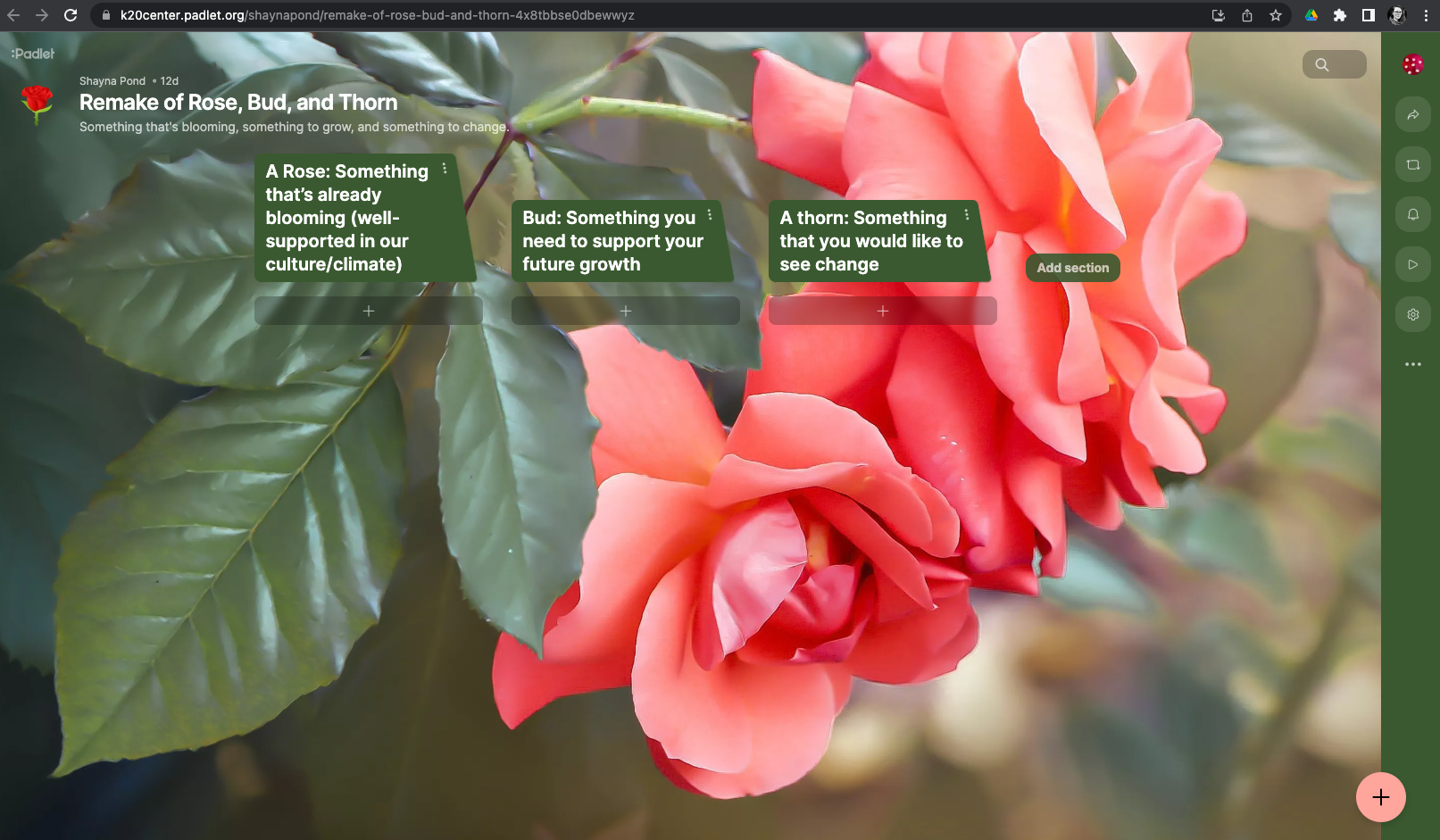Summary
Organizational engagement climate refers to the ability of a group of employees to perceive the energy and commitment needed to work together to achieve organizational goals. Positive organizational climates result from employees having the organizational resources they need to do their work, having a sense of how their work brings meaning to their lives, and feeling as though they are part of a community in the workplace. This professional learning session is part of a series that explores the eight aspects of organizational culture and climate measured by K20's research-based survey. Participants will look at the research factors that support climate and community and then reflect on the data collected from their school survey to create a goal for improving the climate and community at their school.
Essential Questions
How does employee engagement support organizational climate and community?
Materials List
Inflatable beach ball with six colors (6)
Presentation slides
Values Chart (1 per participant)
Climate and Community Research Brief (1 per participant)
Chain Notes Handout (1 set per table group, print one side only)
Pen/pencil (1 per participant)
Device with internet access (at least 1 per table group)
Learning Goals
Explore research-based characteristics of Climate and Community
Analyze survey constructs and data in the context of their organization
Apply strategies to their role within their team and organization
Engage
Display slide 2 to introduce the beach ball toss activity. Number off participants 1-6 to create six groups; each group should have one beach ball. This activity breaks the ice and helps engage prior experiences where participants may have felt engaged in their work.
Move to slide 3 to display the color-coded questions. Participants toss the ball to each other within their group. When a participant catches the beach ball, they answer the color-coded question according to the color their right thumb is touching.
Orange: Describe a time you felt really engaged in a project at work.
Red: Describe a time when you bragged about your work.
Blue: Describe a time when you were working and lost track of time.
Green: Describe a time when you were collaborating and your initial idea blossomed into something extraordinary.
White: Describe a time when you were recognized for your work.
Yellow: Describe a time you felt really connected to your coworker(s).
Encourage participants to continue tossing the ball until each participant has answered at least one question.
Move to slide 4 and read the essential question. Move to slide 5 and review the objectives for this session.
Explore
Begin by handing out the Values Chart one per participant at a time. At this time, ask them to fill out only the first two columns as pictured on slide 6. The purpose of this activity is for participants to individually reflect on what engages them in their work.
Explain
Next, display slide 7 and hand out the attached Research Brief. Use the Stop and Jot strategy and ask participants to stop after each paragraph and write notes.
Then, move to slide 8 and ask participants to complete the last column of their Values Chart.
Show slide 9. Ask tables to discuss as a group the notes they made during the Stop and Jot reading activity and what they learned about their own work orientation. Each table should brainstorm a goal for ways to nurture a positive climate and community at their school.
Extend
Display slide 10 and allow participants 5-10 minutes to view and read through the data. Encourage participants to chat with their table group and ask questions.
Move to slide 11 to introduce the It says, I say, and So… instructional strategy. Read and discuss the example on the slide with participants. Then, ask participants to get into groups of two and pass out the Chain Notes Handout (one set per group). Move to slide 12. Each partner should have a different construct (Organizational Engagement Climate or Social Embeddedness). Instruct participants to write their answer to the first question on the handout. Remind them to answer only the first question.
Move to slide 13 and ask them to pass their paper to their partner. Next, ask participants to answer only the second question on the paper they just received. Move to slide 14 and tell participants to pass their paper to their partner again. Instruct them to answer only the second question on the handout.
Once everyone has finished answering the third question, move to slide 15. Tell participants to take turns at their table to read aloud all of the answers to the questions on their paper.
Show slide 16. Next, instruct participants to summarize key takeaways to share out with the whole room. Each table group should select one participant from their group to share.
Evaluate

Show slide 17. Ask each participant to make a post in each of the three columns. (This strategy is called Rose, Bud, and Thorn).
Rose: Something that’s already blooming (well-supported in our culture/climate)
Thorn: Something you would like to see change
Bud: Something you need to support your future growth
Follow-Up Activities
Gather the themes of the ideas written on the Chain Notes handouts.
What connections do you draw between the responses for climate and community?
What ideas, positions, or assumptions do you want to challenge or question?
What key concepts or ideas do you think are important and worth focusing on moving forward?
What changes in attitudes, thinking, or action are suggested by the staff feedback either for the whole school or for teams?
Have each leader create a summary statement of the key points and identify 1-2 actionable items.
Share the themes and action items with staff. Have each person create their own summary statement of the themes and identify 1-2 actionable items for themselves.
Research Rationale
Researchers have been working to pinpoint the factors that enable organizations and their employees to achieve essential goals. Two important constructs have emerged from their studies. The first construct, (1) organizational engagement climate, refers to the ability of a group of employees to perceive the energy and commitment needed to work together to achieve organizational goals (Albrecht et al., 2018). Employees can have an easier time attaining these goals when an organization makes various (2) organizational resources available to them. The other construct, (3) work orientation, refers to how work brings meaning into an individual’s life (Willner et al., 2020). Work orientation is multi-faceted, but one aspect of the construct that deserves particular attention is (4) social embeddedness, which is an individual’s ability to feel as though they are part of a community in the workplace.
Resources
Albrecht, S., Breidahl, E., & Marty, A. (2018). Organizational resources, organizational engagement climate, and employee engagement. The Career Development International, 23(1), 67-85.
Bellah, R. N., Madsen, R., Sullivan, W. M., Swidler, A., & Tipton, S. M. (1985). Habits of the heart: Individualism and commitment in American life. University of California Press.
Biggs, A., Brough, P., & Barbour, J. P. (2014). Strategic alignment with organizational priorities and work engagement: A multi-wave analysis. Journal of Organizational Behavior, 35(3), 301-317.
Cardador, M. T. (2008). Re-orienting the career orientation: Implications for hybrid work orientations. Paper presented at the annual meeting of the Academy of Management, Anaheim, CA.
Denison, D., Nieminen, L., & Kotrba, L. (2014). Diagnosing organizational cultures: A conceptual and empirical review of cultural effectiveness surveys. European Journal of Work and Organizational Psychology, (23)1, 145-161.
Duffy, R. D., Foley, P. F., Raque-Bogdan, T. L., Reid-Marks, L., Dik, B. J., Castano, M. C., & Adams, C. M. (2012). Counseling psychologists who view their careers as a calling: A qualitative study. Journal of Career Assessment, 20, 293-308.
Hayward, M. D., Hardy, M. A., & Liu, M. C. (1994). Work after retirement: The experiences of older men in the United States. Social Science Research, 23, 82-107.
K20 Center. (n.d.). It says, I say, and so… Strategies. https://learn.k20center.ou.edu/strategy/1514
K20 Center. (n.d.). Padlet. Tech Tools. https://learn.k20center.ou.edu/tech-tool/1077
K20 Center. (n.d.). Rose, bud, and thorn. Strategies. https://learn.k20center.ou.edu/strategy/2224
K20 Center. (n.d.). Stop and jot. Strategies. https://learn.k20center.ou.edu/strategy/168
Maestas, N. (2010). Back to work: Expectations and realizations of work after retirement. Journal of Human Resources, 45, 718-748.
Patterson, M. G., West, M. A., Shackleton, V. J., Dawson, J. F., Lawthom, R., Maitlis, S., Robinson, D. L., & Wallace, A. M. (2005). Validating the organizational climate measure: Links to managerial practices, productivity and innovation. Journal of Organizational Behavior, 26, 379-408.
Willner, T., Lipshits-Braziler, Y., & Gati, I. (2020). Construction and initial validation of the Work Orientation Questionnaire. Journal of Career Assessment, 28(1), 109-127.
Wrzesniewski, A., McCauley, C., Rozin, P., & Schwartz, B. (1997). Jobs, careers, and callings: People’s relations to their work. Journal of Research in Personality, 31, 21-33.


